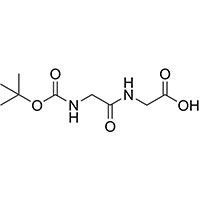Boc-Glycylglycine Boc-Gly-Gly-OH
Nanjing Finechem Holdings Co., LTD
Synonyms
2-[[2-[(2-methylpropan-2-yl)oxycarbonylamino]acetyl]amino]acetic acid
Glycine, N-[(1,1-dimethylethoxy)carbonyl]glycyl-
N-{[(2-Methyl-2-propanyl)oxy]carbonyl}glycylglycine
N-(tert-Butoxycarbonyl)glycylglycin
N-(tert-butoxycarbonyl)glycylglycine
MFCD00038558
Boc-Gly-Gly-OH
Product Description
Introduction:
Boc-Glycylglycine, also known as Boc-Gly-Gly-OH, is a significant chemical compound with various
applications in the chemical industry. This product introduction aims to provide an overview of
Boc-Glycylglycine, covering its raw materials, production process, market trends, and the current status
of amino acids in the industry.
Raw Materials:
Boc-Glycylglycine is synthesized using glycine and Boc anhydride as the primary raw materials. Glycine,
an amino acid, and Boc anhydride (tert-butyloxycarbonyl anhydride) serve as the precursors for the
synthesis of Boc-Glycylglycine.
Production Process:
The production process of Boc-Glycylglycine involves the following steps:
Step 1: Protection - Glycine is protected by reacting it with Boc anhydride to form Boc-Glycine. This
process protects the amino group of glycine and allows further reactions without unwanted side
reactions.
Step 2: Coupling - Boc-Glycine is then coupled with glycine using suitable coupling agents or reagents
to form Boc-Glycylglycine. The reaction is typically carried out in an appropriate solvent under
controlled conditions.
Step 3: Deprotection - The Boc protecting group is removed from Boc-Glycylglycine using acid or base
hydrolysis, resulting in the formation of Boc-Glycylglycine (Boc-Gly-Gly-OH).
Market Trends:
The market demand for Boc-Glycylglycine has been increasing due to its versatile applications in various
industries. Here are some key market trends:
Peptide Synthesis: Boc-Glycylglycine is commonly used in peptide synthesis as a building block to create
more complex peptide structures. It serves as a link between other amino acids, enabling the creation of
specific peptide sequences.
Pharmaceutical Research: Boc-Glycylglycine finds applications in pharmaceutical research and drug
development. It can be used as a starting material for the synthesis of potential drug candidates or as
a reference standard in analytical testing.
Current Status of Amino Acids:
Amino acids play a crucial role in various sectors, including pharmaceuticals, peptide synthesis, and
biochemistry. They are fundamental units of proteins and have diverse functions in the human body.
Glycine, in particular, is one of the most abundant amino acids and has applications in various
industries.
Conclusion:
Boc-Glycylglycine (Boc-Gly-Gly-OH), derived from the coupling of Boc-Glycine and glycine, is an
important compound in the chemical industry. Its production involves the protection and coupling of
glycine, followed by deprotection to obtain Boc-Glycylglycine. The market demand for Boc-Glycylglycine
is driven by its applications in peptide synthesis and pharmaceutical research. Amino acids, including
glycine, continue to be essential components in various industries, contributing to advancements in
chemical applications and biomedical research.





